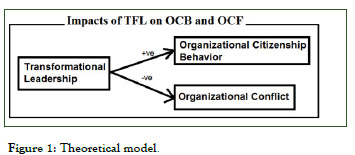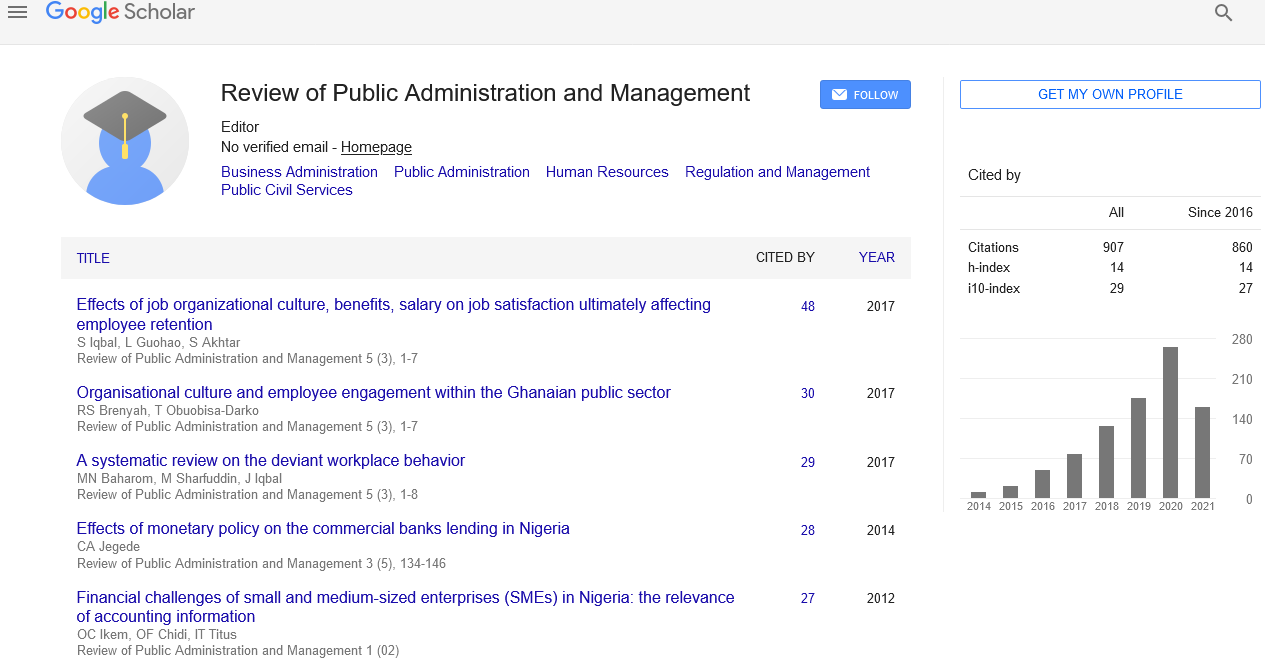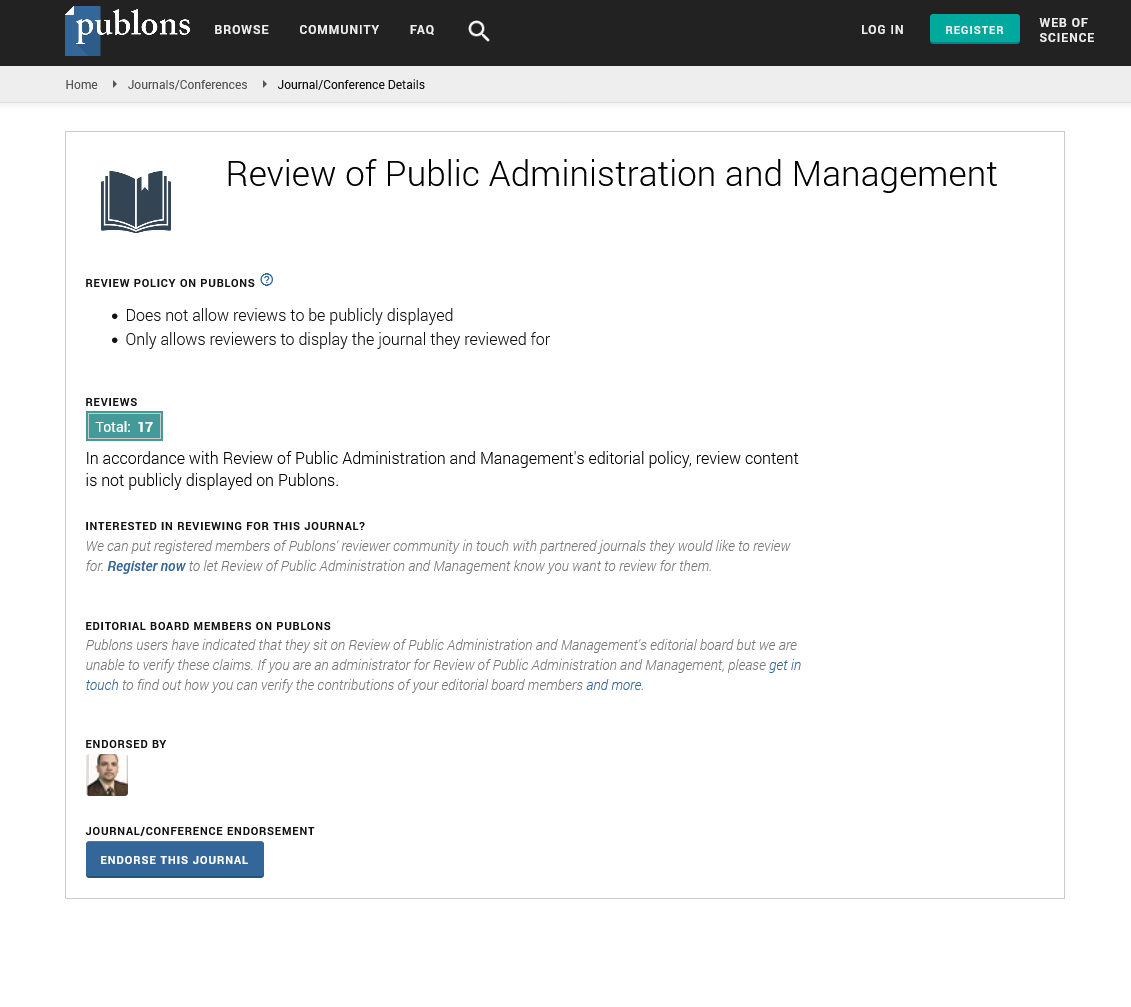Indexed In
- CiteFactor
- RefSeek
- Directory of Research Journal Indexing (DRJI)
- Hamdard University
- EBSCO A-Z
- Scholarsteer
- Publons
- Euro Pub
- Google Scholar
Useful Links
Share This Page
Journal Flyer

Open Access Journals
- Agri and Aquaculture
- Biochemistry
- Bioinformatics & Systems Biology
- Business & Management
- Chemistry
- Clinical Sciences
- Engineering
- Food & Nutrition
- General Science
- Genetics & Molecular Biology
- Immunology & Microbiology
- Medical Sciences
- Neuroscience & Psychology
- Nursing & Health Care
- Pharmaceutical Sciences
Research Article - (2024) Volume 12, Issue 4
Impacts of Transformational-Leadership on Organizational Citizenship-Behavior (+) and Organizational-Conflict (-): A Survey of University Teachers in Khyber Pakhtoonkhwa, Pakistan
Muhammad Siddique*Received: 23-Jul-2020, Manuscript No. RPAM-24-5560; Editor assigned: 28-Jul-2020, Pre QC No. RPAM-24-5560 (PQ); Reviewed: 11-Aug-2020, QC No. RPAM-24-5560; Revised: 16-Aug-2024, Manuscript No. RPAM-24-5560 (R); Published: 13-Sep-2024, DOI: 10.35248/2315-7844.24.12.472
Abstract
Transformational-Leadership (TFL) is a popular style on planet due to its human-oriented behavior accommodating required transactional mode of leading as and when required to practice task-oriented organizational behavior. TFL is a new version of ‘charismatic-leadership’, having expanded attributes of: Idealized-influence, inspirational-motivation, intellectual-stimulation and individualized-consideration-as the core behaviors of the leader.
Keywords
Transformational-leadership; Organizational citizenship behavior; Khyber pakhtoonkhwa; Organizationalconflict
Introduction
TFL cares about followers at individual, group/team and organizational levels of performance thereby creating employeefriendly work-place where Organizational Citizenship Behavior (OCB) is naturally enhanced/supported and likelihood of conflicts is reduced at individual, group and corporate levels of organizational operations. Current study is about the verification of cause-n-effect relations of TFL with OCB and OCF in the work-environment of higher education, Khyber Pakhtoonkhwa, Pakistan.
Transformational leadership
After a review of the long history on theories of leadership and styles, one comes to the current popular model of transformational vs. transactional styles of leadership wherein former has more human inclination while latter is task-oriented. Given that both styles are needed in every organization to lead human and manage things. Therefore, most of the organizations are struggling hard to transform their organizations as per transformational mode of leadership. This is so because research on HRM has proved with evidence that it is primarily humans who make or break the present and future of any organization being run by human beings.
Transformational leadership is the most inspiring style of leadership which transforms workers to use their potentials at fuller level in order to catch the goals of the organization. This type of leader plays a model role to inspire and motivate followers for the achievement of corporate goals. Transformational leader possess enough knowledge about the abilities of his staff, assign them duties and tasks of unique nature and equip them with power and authority to perform their duties very well. Such a leader pays proper attention to every employee to fulfill their needs and to make them realize that they are vital to the organization. Thus, the transformational leaders develop a sense of ownership among employees which results in increased motivation, loyalty, commitment and dedication where workers perform at optimum level for the productivity and growth of the organization.
Organizational Citizenship Behavior (OCB)
Organizational Citizenship Behavior is a special behavior with which an employee performs beyond job description to best serve the interest of the organization [1]. The OCB involves assisting co-workers in task completion, owning the organization and its elements (goals, resources, rules, etc.) and performing beyond expectations of the management. OCB in any organization happens due to the fact that either workers want to return their favor to the organization or they are more satisfied and own the organization and its management.
The researchers grouped the salient features of OCB into seven categories i.e., helping performance, supportiveness, managerial constancy, managerial observanc, personal idea, public virtue and self-development. Other researchers mentioned five groupings of OCB, i.e., individualism, courtesy, emotional stability, teamwork and civil virtue. Supportive attitude and behavior is the virtue of OCB where every worker helps others in task completion, minimize public inconvenience and play their role in the prevention of possible threats [2]. Similarly, the sportsmanship is also an OCB that includes team-motivation, fair play and sacrifice for the benefit of organization.
Organizational conflict
Conflict’ is caused by disharmony and clash of interests and it is a deadlock situation between the stakeholders of the organization. Since organizations are human-oriented entities where different stakeholders represent different segments of the society, thus, conflicts are obvious to arise due to different conflicting interests of each group of people. Conflict may occur at individual, interpersonal, group or corporate level. An individual conflict may occur when an employee may dislike his work or some of its aspects.
Similarly, the interpersonal conflict may occur when a worker dislike working with co-workers [3]. The group conflict occurs when human resource department may have problem with finance department. Finally, the organizational conflict occurs when one organization may have conflict with the other organization.
Some common causes of organizational conflict are: Organizational injustice, negative competition and power struggle which badly hamper the organizational performance and deteriorate its employees’ relations. If conflicts are mis-handled in the organization, it may result into depression, demoralization, dissatisfaction, employees turnover, absenteeism and lockouts [4]. Thus, conflicts may occur in any organization at any level at any time and it tests the competences of administrator/manager that how successfully he negotiates between the conflicting groups (Figure 1).

Figure 1: Theoretical model.
The study reveals that by working on the attributes of transformational leadership, the governing bodies can generate two-way effects of their leadership practices by generating and maintaining OCB among the workforce and simultaneously catch-on any type of work-related conflicts before they get worse and uncontrollable [5]. The study is a precursor to assist the management in higher education of Khyber Pakhtunkhwa, which can be generalized at national level.
Materials and Methods
Philosophy and approach
Current social research using statistical methods as a supplement to the qualitative studies follows the research-philosophy of ‘Positivism,’ which is a package of beliefs about ‘knowledge’ and ‘the way knowledge is collected, stored and communicated.’ The idea is whatever can be verified through observational ‘scientificmethods’, will be accepted as knowledge recorded and transferred using standard concepts. To access data, researcher used ‘survey-approach’ both for literature-based and field data [6]. Further, ‘thematic-analysis’ and ‘statistical-procedures’ were applied to process data into information thereby answering the research questions through testing of hypotheses.
Population and sample
All the university teachers working in the public sector universities of Khyber Pakhtoonkhwa, Pakistan were the population of this study. The population of this study was 3053 teachers working in 16 public sector universities of Khyber Pakhtoonkhwa, Pakistan [7]. Sample is the most representative part of a population. The researcher estimated 265 sample size by using the following statistics (Table 1).
| z-Score | S.D | Std. Error | N | Sample size |
|---|---|---|---|---|
| 1.96 | 0.93 | 0.111959 | 3053 | 265 |
Note: Formula for sample-size=((SD × SD)/((E × E)/(Z × Z))+((SD × SD)/N))
Table 1: Computation of the sample-size.
Reliability and validity
Reliability is the ability of data collection instrument to repeat or produce the same results if applied in the similar situation like filling a questionnaire from same sample twice. Validity is the quality of the instrument to collect exactly what it was supposed to collect [8].
Cronbach-alpha was computed for reliability while validity was tested using factor-analysis following KMO and Bartlett’s tests. Table 2 shows that all the variables are reliable with the Cronbach’s Alpha values greater than 0.7, thus, the instrument is highly reliable and is believed to provide the same data, if repeated on the similar or different sample of respondents [9].
| S.No | Variables | N of Items | Cronbach's Alpha |
|---|---|---|---|
| 1 | Transformational-leadership | 9 | 0.945 |
| 2 | Organizational-citizenship-behavior | 9 | 0.787 |
| 3 | Organizational-conflict | 8 | 0.922 |
| 4 | Questionnaire | 26 | 0.708 |
Table 2: Reliability statistics.
RESULTS AND DISCUSSSION
Descriptive statistics
Table 3 shows the descriptive results of the data, containing sample size, minimum and maximum average score of each variable, mean score and standard deviation of each variable [10].
| S.No | Descriptive statistics | N | Min | Max | Mean | Std. D |
|---|---|---|---|---|---|---|
| 1 | Transformational-leadership | 233 | 2 | 5 | 3.5656 | 0.75087 |
| 2 | Organizational citizenship behavior | 233 | 2.22 | 4.11 | 3.0453 | 0.4411 |
| 3 | Organizational conflict | 233 | 1 | 4 | 2.765 | 0.80419 |
Table 3: Descriptive statistics.
Testing of hypotheses
H-1 TFL is significantly associated with criterion-variables (OCB and OCF).
Table 4 contains the correlation statistics. Here, we can see that transformational leadership has significant positive relationship with the organizational citizenship behavior (with p-value=0.000 and r=0.728), which means that by increasing the intensity of transformational leadership in the organization, the management can enjoy the increasing organizational citizenship behavior and vice versa.
Similarly, it can also be seen in the results that transformational leadership has significant negative relationship with the organizational conflict (with p-value=0.000 and r=-0.650), which means that increasing the level of transformational leadership in the organization, will result in decreasing trend of organizational conflicts and vice versa [11]. Thus, TFL is significantly associated with the OCB and the OCF, which enables the researcher to declare the acceptance of hypothesis-1.
| Variables | Transformational leadership | OCB | |
|---|---|---|---|
| Organizational citizenship behavior | Pearson correlation (r1) | 0.728** | |
| Sig. (2-tailed) | 0 | ||
| Organizational conflict | Pearson correlation (r2) | -0.650** | -0.443** |
| Sig. (2-tailed) | 0 | 0 | |
Note: **Correlation is significant at the 0.01 level (2-tailed)
Table 4: Correlations table.
H-2 TFL significantly (positively) predicts OCB
Table 5 contains the regression analysis results of TFL and OCB. Here, it can be seen that the overall effect of TFL on OCB is R^2 =0.530 (53%), however, its beta (β) value in unstandardized coefficients shows that the individual effect of TFL on OCB is β=0.428 (43% approx). It means that, if 1 standard deviation change is brought in the TFL, it will result in 0.428 standard deviation change in the OCB, thus, showing the positive impacts of TFL on the OCB. This positive relationship of TFL with OCB is already supported by the review of literature, where the transformational leadership through his unique characteristics of idealized influence, intellectual stimulation, inspirational motivation and individualized consideration, may alter the behavior of employees and enable them to play the organizational citizenship behavior. The researcher, therefore, concludes that the hypothesis-2 is accepted [12].
| Model | R | R^2 | Adjusted R^2 | SE of the estimate | ANOVA | ||||
|---|---|---|---|---|---|---|---|---|---|
| F | Sig. | ||||||||
| 1 | 0.728a | 0.53 | 0.528 | 0.30296 | 260.802 | 0.000b | |||
| Coefficients | |||||||||
| Model | Unstandardized coefficients | Standardized coefficients | T | Sig. | |||||
| Β | Std. error | β | |||||||
| 1 | (Constant) | 1.5 | 0.097 | 15.749 | 0 | ||||
| Transformational-leadership | 0.428 | 0.026 | 0.728 | 16.149 | 0 | ||||
Note: aDependent variable: Organizational citizenship behavior; bPredictors: (Constant), TFL
Table 5: Model summary and coefficients.
H-3 OCF is significantly (negatively) explained by TFL
Table 6 shows the regression analysis results of TFL and OCF. Here, it can be seen that the overall effect of TFL on OCF is R^2 =0.423 (42.3%), however, its beta (β) value in unstandardized coefficients shows that the individual effect of TFL on OCF is β=-0.697 (-70% approx). It means that, if 1 standard deviation change is brought in the TFL, it will result in -0.697 standard deviation change in the OCF, thus, showing the negative impacts of TFL on the OCF. Again, this negative relationship between TFL and OCF has already been established in the literature, where the researchers have disclosed the transformational leadership as the ideal type of leadership which has the capability to minimize the likelihood of conflicts at all levels of organization (i.e., individual, group and organizational level conflicts). The researcher, therefore, concludes that the hypothesis-3 is also accepted.
| Model | R | R^2 | Adjusted R^2 | SE of the estimate | ANOVA | ||
|---|---|---|---|---|---|---|---|
| F | Sig. | ||||||
| 1 | 0.650a | 0.423 | 0.421 | 0.61217 | 169.374 | 0.000b | |
| Coefficients | |||||||
| Model | Unstandardized coefficients | Standardized coefficients | T | Sig. | |||
| Β | Std. error | β | |||||
| 1 | (Constant) | 5.2 | 0.195 | 26.915 | 0 | ||
| Transformational-leadership | -0.697 | 0.054 | -0.65 | -13.014 | 0 | ||
Note: aDependent variable: Organizational conflict; bPredictors: (Constant), TFL
Table 6: Model summary and coefficients.
Conclusion
Transformational leaders struggle to install themselves as the role-model in the minds and hearts of their followers. However, this happens when leader makes all out efforts in idealizedinfluence, inspirational-motivation, intellectual-stimulation and individual-consideration. Transformational leader makes his place by creating OCB (performing beyond contractual agreement) and capitalizing on the creativity and innovation of the workforce. He/she leaves no stone unturned to create employee-friendly work-environment wherein the organizationalconflicts find no way to flourish. So the leader creates such working conditions where employees feel at home therefore inspired to contribute.
Current study confirms the impacts of transformational leadership practices as supportive to OCB and the best tool to manage organizational conflicts existing at individual, group and corporate levels of performance. The HRM of higher education is therefore suggested to allow transformational leadership models in higher education institutions to transform the workforce into motivated and anti-conflict team of workers inspired with organizational citizenship behavior.
References
- Dierdorff EC, Rubin RS, Bachrach DG. Role expectations as antecedents of citizenship and the moderating effects of work context. J Manag. 2012;38(2):573-598.
- Kwantes CT, Karam CM, Kuo BC, Towson S. Culture's influence on the perception of OCB as in-role or extra-role. Int J Intercul Relat. 2008;32(3):229-243.
- Velickovska I. Organizational citizenship behavior-definition, determinants and effects. Eng Manag J. 2017.
- Majeed N, Ramayah T, Mustamil N, Nazri M, Jamshed S. Transformational leadership and organizational citizenship behavior: Modeling emotional intelligence as mediator. Manag Mark. 2017;12(4):571-590.
[Crossref] [Google Scholar] [PubMed]
- Majeed N, Nor MN, Mustamil NM. Exploring relationship between transformational leadership and organizational citizenship behaviors through lens of workplace spirituality. Inter Online J Educ Leadership. 2017;1(1):5-33.
- Jyoti J, Bhau S. Empirical investigation of moderating and mediating variables in between transformational leadership and related outcomes: A study of higher education sector in North India. Int J Edu Manag. 2016;30(6):1123-1149.
- Kim EJ, Park S. The role of transformational leadership in citizenship behavior: Organizational learning and interpersonal trust as mediators. Int J Manpow. 2019;40(7):1347-1360.
- Alamir I, Ayoubi RM, Massoud H, Hallak LA. Transformational leadership, organizational justice and organizational outcomes: A study from the higher education sector in Syria. Leadership Org Dev J. 2019;40(7):749-763.
- Dewi DY, Supriadi YN, Iswanto AH. The effect of transformational leadership, quality of work-life on organizational citizenship behavior with organizational commitment mediation. J Soc Sci. 2022;3(2):308-323.
- Doumi FA. A newly tested transformational leadership-organizational citizenship behavior model: Among the employees of the Jordanian universities: An empirical study. J Soc Sci. 2022;11(4):102-120.
- Budur T, Demir A. The relationship between transformational leadership and employee performance: Mediating effects of organizational citizenship behaviors. Interdiscip J Manag Stud. 2022;15(4):899-921.
- Mufeed U. An empirical study of transformational leadership and quality of work life in higher educational institutions. Int J Leadership. 2018;6(2):40-46.
Citation: Siddique M (2024) Impacts of Transformational-Leadership on Organizational Citizenship-Behavior (+) and Organizational-Conflict (-): A Survey of University Teachers in Khyber Pakhtoonkhwa, Pakistan. Review Pub Administration Manag. 12:472.
Copyright: © 2024 Siddique M. This is an open-access article distributed under the terms of the Creative Commons Attribution License, which permits unrestricted use, distribution, and reproduction in any medium, provided the original author and source are credited.


